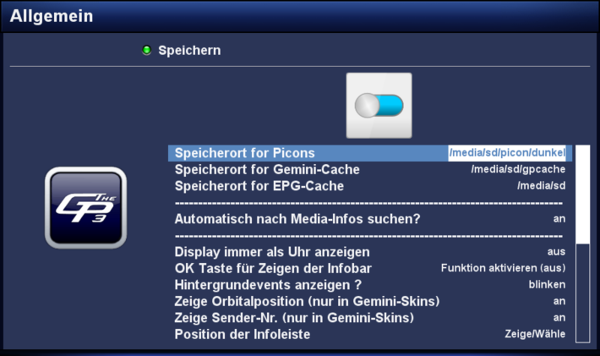GP3 general settings (en)
Inhaltsverzeichnis
- 1 Path for Picons
- 2 Path for Gemini-Cache
- 3 Path for EPG-Cache
- 4 OK button to show the Infobar
- 5 Background events
- 6 Show orbital position (only in Gemini-Skins)
- 7 Display channel number (only in Gemini-Skins)
- 8 Position of the infobar
- 9 Search Updates daily
- 10 Nur root bei 'OPKG' nutzen
- 11 extra Plugins benutzen?
- 12 Sprachen entfernen?
- 13 Virtual Desktop
The general settings of the GP3 Plugin can be opened over: [BluePanel] ➤ [Settings] ➤ [general]. The following descriptions explain the possible settings.
| Saving the settings Always save the settingswith the [green] button. |
Path for Picons
Here the path for saving the Picons is specified. With pressingthe [OK] button the file manager is opened. There you can choose the directory. It's recommended to save the picons on /media/cf, /media/sd or /media/usb (especially for smaller boxes). Of course the corresponding device needs to be mounted over the device manager. The path /media/hdd should not be used, because the hard disk will be activated with each access on a picon (e.g. while zapping).
Path for Gemini-Cache
Here the path for saving the GP3-cache is specified. With pressingthe [OK] button the file manager is opened. There you can choose the directory. It's recommended to save the picons on /media/cf, /media/sd or /media/usb (especially for smaller boxes). Of course the corresponding device needs to be mounted over the device manager. The path /media/hdd should not be used, because the hard disk will be activated with each access on the GP3 Blue Panel. In the cache all possible temporary files for GP3 are saved.
Path for EPG-Cache
Here the path for saving the EPG-cache is specified. With pressingthe [OK] button the file manager is opened. There you can choose the directory. It's recommended to save the picons on /media/cf, /media/sd or /media/usb (especially for smaller boxes). Of course the corresponding device needs to be mounted over the device manager. This file is only saved after stopping Enigma2 / shutting donw the Box. This means the file is not available while the box is used. The epg.dat stores the EPG data.
OK button to show the Infobar
With this setting [on], the infobar is showed after pressing [OK]. A second press on [OK] closes the infobar again.
Background events
With this setting the notifications are activated in the Infobar. The notifications can be switched on blinking, permanent or disabled.
Show orbital position (only in Gemini-Skins)
With the setting [on] the orbital position is displayed in the infobar (e.g. 19.2°E).
For this function a GP-Skin needs to be installed.
Display channel number (only in Gemini-Skins)
With the setting [on] the channel number is displayed inthe infobar (e.g. 13) angezeigt.
For this function a GP-Skin needs to be installed.
Position of the infobar
after pressing [OK], it's possible to move the Infobar on the TV screen with the remote control. With the [OK] button the new selected position is saved.
Search Updates daily
With this option activated GP3 will search daily for updates and display a notification in a GP3-Skin. The Notifications can be displayed as UP in the infobar, as icon on the TV or as Message.
Nur root bei 'OPKG' nutzen
Wenn die Paketverwaltung (opkg) am Arbeiten ist, legt sie Informationen auf Geräten an, die in der Konfigurationsdatei /etc/opkg/opkg.conf definiert sind. Je nach Konfiguration, werden die Informationen im Verzeichnis /media, in die Ordner ram, usb und hdd geschrieben. Nachteil ist, dass die Festplatte immer vom Standby Modus aufgeweckt wird. Dieses Verhalten entspricht der Einstellung [aus] in den Einstellungen des GP Plugins.
Die Einstellung [ein] verändert das Verhalten der Paketverwaltung, dass die Informationen nur im Flashspeicher abgelegt werden. Die Festplatte bleibt bei dieser Einstellung im Standby Modus und wird nicht mehr aufgeweckt.
extra Plugins benutzen?
Bei der Einstellung [ein] wird ein zusätzlicher Software-Feed mit dem Namen gemini-extraPlugins-feed.conf im Verzeichnis /etc/opkg erstellt. Auf dem Software-Feed liegen zusätzliche Plugins (z.B. AMS), welche über die Paketverwaltung (z.B. den Addons) installiert werden können.
Sprachen entfernen?
Hier habt ihr die Möglichkeit, unbenutzte Enigma 2 Sprachdateien im Verzeichnis /usr/share/enigma2/po zu löschen. Dadurch könnt ihr zusätzlichen Speicherplatz gewinnen. Drückt die [OK], um die Liste der Dialogsprachen zu öffnen. Alle grün markierten Einträge sind installiert und können entfernt werden. Rot markierte Einträge sind im System nicht vorhanden. Wählt jetzt alle Sprachen aus, die entfernt werden sollen und drückt die [OK] Taste. Die gewählten Sprachen werden mit der Farbe Rot markiert. Die Standardsprache Englisch kann nicht entfernt werden. Schliesst nach der Auswahl das Fenster mit der [Exit] Taste und bestätigt die Abfrage "Sollen Sprachen gelöscht werden" mit [Ja]. Hinweis: Nach einem Enigma2 Update werden die Sprachen auch wieder automatisch entfernt.
Virtual Desktop
Um den Virtuellen Desktop benutzen zu können, muss es zuerst über die GP3 Addons installiert werden und steht nach einem Enigma 2 Neustart zur Verfügung. Der virtuelle Desktop erweitert das BP auf bis zu 6 Ansichten. In jedem einzelnen Desktop können dann die Erweiterungen zugewiesen werden. Damit wird das Blue Panel übersichtlicher, weil nicht alles auf einer Seite dargestellt wird.
